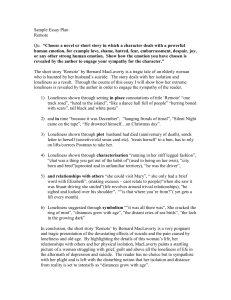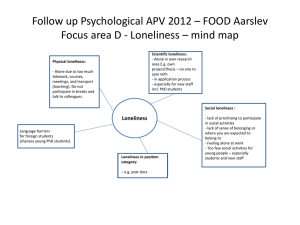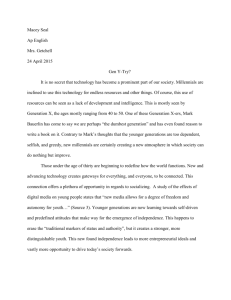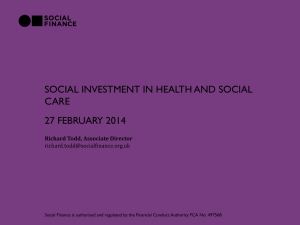Support giving patterns - Netherlands Kinship Panel Study
advertisement
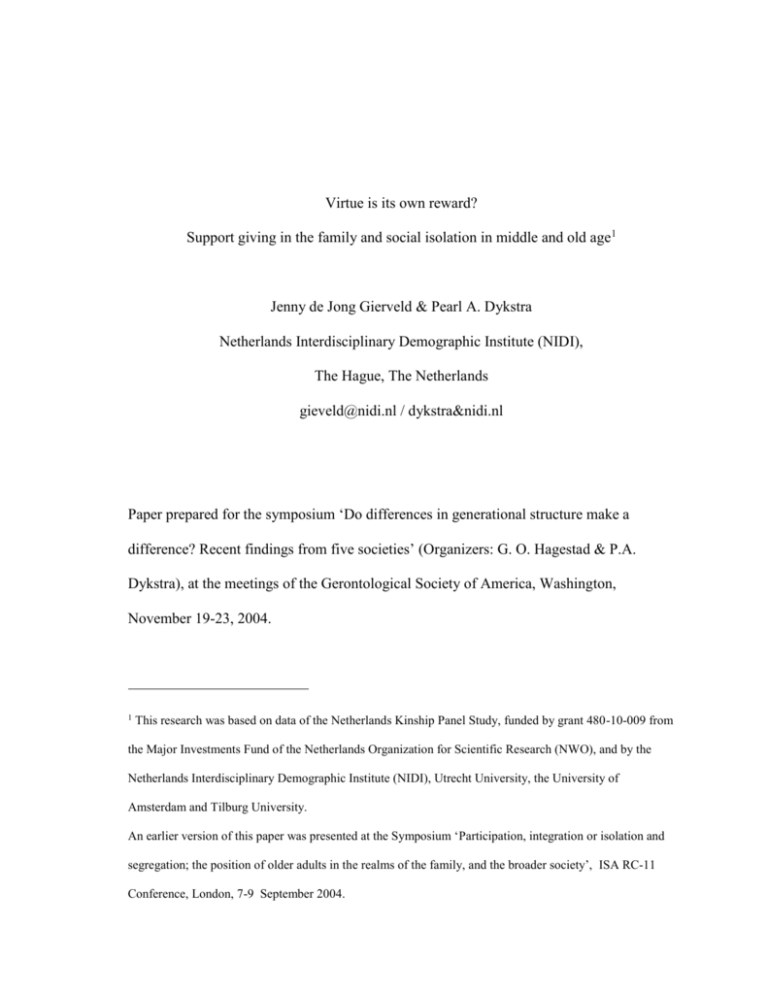
Virtue is its own reward? Support giving in the family and social isolation in middle and old age1 Jenny de Jong Gierveld & Pearl A. Dykstra Netherlands Interdisciplinary Demographic Institute (NIDI), The Hague, The Netherlands gieveld@nidi.nl / dykstra&nidi.nl Paper prepared for the symposium ‘Do differences in generational structure make a difference? Recent findings from five societies’ (Organizers: G. O. Hagestad & P.A. Dykstra), at the meetings of the Gerontological Society of America, Washington, November 19-23, 2004. 1 This research was based on data of the Netherlands Kinship Panel Study, funded by grant 480-10-009 from the Major Investments Fund of the Netherlands Organization for Scientific Research (NWO), and by the Netherlands Interdisciplinary Demographic Institute (NIDI), Utrecht University, the University of Amsterdam and Tilburg University. An earlier version of this paper was presented at the Symposium ‘Participation, integration or isolation and segregation; the position of older adults in the realms of the family, and the broader society’, ISA RC-11 Conference, London, 7-9 September 2004. Abstract Recently gerontologists have emphasized that older adults are not only recipients of support but also important support providers. In this paper we examine the adage that virtue is its own reward. More specifically we examine whether support giving in the family by adults aged 45-79 helps prevent feelings of social isolation in this group. We distinguish support given to age peers, and to younger and older family generations. The data are from the 2002-2004 Netherlands Kinship Panel Study (NKPS). Analyses of the generational structure of Dutch kin networks show that three-generation families are the norm in the Netherlands, not four generations as many people believe. Approximately four percent are in so-called solo generation families, that is, they have no descending or ascending kin. Support giving patterns are better predictors of feelings of social isolation than are characteristics of the generational structure of the kin network. As regards support giving patterns, the direction of support giving (up, within or down the family lineage) contributes less to the prevention of feelings of social isolation than the number of family generations supported. The greater the number of family generations to which support is given, the less socially isolated middle-aged and older adults feel. The adage that virtue is its own reward, seems to be true. 2 Keywords: family, generations, social isolation, older adults, support giving 3 Virtue is its own reward? Support giving in the family and older adults’ social isolation Gerontology has witnessed a shift from viewing older adults primarily as recipients of support to acknowledging that older adults are also important providers of support. Within families, more support flows down generations than flows up (Cheal, 1983; Kohli, Künemund, Motel & Szydlik, 2000a). In this paper we examine whether support giving in the family helps prevent feelings of social isolation among middle aged and older adults. The architecture of families has changed under the influence of changing fertility and mortality patterns (Bengtson, 2001). First of all, families have become narrower from a horizontal perspective (the beanpole family): there has been a decline in intragenerational relationships, that is to say, ties between members of the same generation, such as brothers and sisters and cousins, owing to the fact that couples are having fewer children. A second development is the ongoing verticalization of families. Families are made up of several generations. Due to the extended life span, older family members are living longer than they did in the past. This means that three, four or even five generations may be alive at the same time. Another consequence of the extension of the life span is that family ties have a duration of unprecedented length. Family members are alive together for increasing lengths of time. It is not uncommon for parents and children to share a period of 50 or 60 years. The previously described demographic changes form the backdrop for our first research question: To what extent are men and women aged 45 and over involved in 4 support giving to younger and older family generations? To answer this question we will first describe the generational structure of the kin networks in which middle aged and older adults are embedded. Next we will describe support giving patterns, distinguishing support given up the family lineage (to parents), down the family lineage (children) and within the family lineage (siblings). We focus on support given to adult family members. Our second research question considers the implications of support giving: Does the association between support giving and feelings of social isolation differ, depending on the direction of support giving? Does it matter whether support is given up, down or within the family lineage? Hypotheses Though the nature of the parent-child relationship changes intrinsically when children grow up and become adults with lives of their own (Rossi & Rossi, 1990), parents’ primary orientedness towards their children’s well-being continues. Once a parent, always a parent. We argue that the caring for and supporting of children are desired and voluntary activities of parents of all ages, and for that reason constitute the basis for well-being of parents of all ages. This brings us to hypothesis 1: Support given to a younger family generation helps prevent feelings of social isolation among middle aged and older adults. Adult men and women engage in all kinds of exchanges with their children and their parents, and their relationships are generally characterised as close (Klein Ikkink, Van Tilburg, Knipscheer, 1999). Adult children tend to support their parents in carrying out household and personal care tasks, whereas parents tend to provide financial support 5 to their adult children (Kohli, Künemund, Motel & Szydlik, 2000b). Children respond to the onset of physical decline of their parents by increasing their support provision (Broese van Groenou, & Knipscheer, 1999): sons tend to specialize in the provision of instrumental support whereas daughters are more likely to provide emotional support. However, changing societal values concerning the role of the family versus that of the public sector in providing care have affected the relationships between family members (Fokkema, De Ruijter, & Maas, 2003; Komter, & Vollebergh, 2002; Pyke, 1999). Concomitant with processes of emancipation, secularization and individualization, the basis of contacts between older and younger generations of family members has shifted from obligatory to more voluntary. If relations between family members are more and more voluntary, then support giving can be viewed as a demonstration of affection. This brings us to hypothesis 2: Support given to a younger generation in combination with support given to other family members (older or same generation) more strongly prevents feelings of social isolation than support given to a younger generation alone. Family relationships are not always a source of joy (Antonucci, 1990; Murphy, Schofield, Nankervis, Bloch, Herrman, & Singh, 1997; Rook, 1990; Walen, & Lachman, 2000). It is especially support giving and care providing to members of the older generation that seems to have negative consequences. Starting to care for an older parent entails a shift of authority in the child-parent relationship and requires time and energy from the daughter or son involved. The burden experienced by people in so-called sandwich positions who are faced with the competing demands of caring for both children and parents (Brody, 1981) stems possibly from needing to cognitively deal with the changing nature and the functioning of the relationship to their parents, in addition to 6 being confronted with complex time pressures. Though caring for older parents appears to be more and more a matter of choice and of voluntarily stepping in given the availability of formal and institutional care, caring decisions are nevertheless governed by feelings of obligation for many (Connidis & McMullin, 2002; Finch & Mason, 1993). Those with extensive care tasks are more likely to experience negative consequences, e.g., a larger need for assistance, a greater desire to consult with other family members, and an increased sense of social isolation (Cicirelli, 2000; Kendig, Koyano, Asakawa, & Ando, 1999; Knipscheer, & Broese van Groenou, 2004; Silverstein, & Chen, 1996). Within this context, we formulate hypothesis 3 –competing with hypothesis 2– : Support given to a younger generation in combination with support to other family members (especially the older, but also the same generation) less strongly prevents feelings of social isolation than than support given to a younger generation alone. Methods Respondents The data came from the main sample of the Netherlands Kinship Panel Study (Dykstra, Kalmijn, Knijn, Komter, Liefbroer, & Mulder, 2004). In the period October 2002 until January 2004 face-to-face interviews using a CAPI questionnaire were conducted with 8154 men and women with a minimum age of 18 and a maximum age of 79. At the end of the interview, respondents received a self-completion questionnaire that was picked up by the interviewer at a later date. The self-completion questionnaire mostly pertained to subjective issues (attitudes, well-being). In 90 percent of the cases the self-completion questionnaire was returned and processed. 7 A random sample of addresses of private residences in the Netherlands was used; the addresses were from all over the Netherlands and not restricted to specific regions or municipalities. Residents of care-institutions, penitentiaries, homes for the elderly, and holiday homes were excluded from the sample frame. The overall response rate of the NKPS study was 45 percent. One has to keep in mind that in general the response rates in the Netherlands are low as compared to e.g. the US; the Family Survey Dutch Population 1998 e.g. yielded an overall response rate of 47 percent. The overall response rate for the NKPS was lowest in the most urbanized regions, mostly attributable to both a lower contact rate and a lower likelihood of cooperating given contact. In general, men and particularly men in the youngest age categories living with their parents, and women living alone were under-represented in the main sample. Measuring instruments Generational structure kin network. During the interview questions were asked about, among others, the existence of biological children, biological siblings, parents, grandparents and grandchildren. Support giving. Questions about support exchanges were asked for a selected set of non co-resident family members: mother, father, a randomly selected parent in law, a maximum of two randomly selected biological or adopted children aged 15 or over, and a maximum of two biological or adopted siblings aged 15. We used information on the provision of financial, emotional or instrumental support. The items were: (1) ‘In the last three months, did you give help to […] with housework, such as preparing meals, cleaning, fetching groceries, doing the laundry?’ (2) ‘In the last three months, did you give 8 help to […] with practical matters such as chores in and around the house, lending things, transportation, moving things?’ (3) ‘Have you donated […] valuable objects or a substantial amount of money in the past 12 months? Please include any monthly transfers.’ (4) ‘Have you shown an interest in the personal life of […]?’ (5) ‘Did you give council or good advice to […] in the last three months?’ Given that it is difficult to equate different aspects of intergenerational exchanges like care, domestic support, and financial provisions (Bengtson & Roberts, 1991), we refrain from an examination of different kinds of support. Rather we use aggregate measures: support giving to children, i.e. a younger generation (yes/no), support giving to brothers or sisters, i.e. the same generation (yes/no), and support giving to father, mother, and a parent in law, i.e. an older generation (yes/no). Note that we use a subjective definition of support giving, including all kinds of exchanges (instrumental, emotional and financial support) directed to non resident family members, as reported by the respondent. Social isolation. We used two measures of social isolation. The first pertained to perceived embedment in the family, namely the question: ‘To what extent do you feel accepted by your family?’, with four answer categories ranging from (1) I feel not at all accepted , to (4) I feel entirely accepted. The second was a more general measure, namely the degree of loneliness, using the De Jong Gierveld measuring instrument which consists of five positive and six negative items (De Jong Gierveld, & Kamphuis, 1985; De Jong Gierveld, & Van Tilburg, 1999). The positive items assess feelings of belongingness, whereas the negative items assess feelings of social loss or disappointment. An example of a negatively formulated scale item is: ‘I experience a sense of emptiness around me’. An example of a positively formulated item is: ‘I can rely on my friends whenever I need 9 them’. The loneliness scale has a range of 0 (not lonely) to 11 (extremely lonely). The scale was part of the self-completion questionnaire, implying that we had missing information for about ten percent of the respondents. The scale has been used in several surveys and proves to be a reliable and valid instrument (Pinquart, & Sörensen, 2001). Background characteristics included information about the partner status of the respondent: ‘Do you have a partner at the moment, that is to say, someone with whom you have had a relationship for at least three months?’ (Spouses are included in the category of ‘partner’). Information about the educational level of the respondent was delineated via the question: ‘What is the highest level of education that you pursued?’, and answers ranged from (1) did not complete elementary school, to (10) post-graduate. Current employment status was investigated by the question: ‘Do you currently have a paid job? (A few hours a week or temporary work also count.) Yes or no?’. Physical restrictions were measured by asking: ‘I will now ask some questions about your health. How is your health in general?, with answer categories ranging from (1) excellent, to (5) very poor. Procedure The analyses reported in the present paper are based on data from 4185 men and women aged 45 and over. Before moving on to multivariate analyses, we examined the bivariate associations between feeling accepted by the family and loneliness on the one hand, and (a) background characteristics, (b) characteristics of the generational structure of the kin network, and (c) support giving patterns on the other hand. To examine the relative contributions of characteristics of the generational structure of the kin network and support giving patterns to the explanation of social isolation we conducted analyses of 10 variance (ANOVA) with multiple classification analysis for possible non-linear associations. Background characteristics were introduced as covariates. In the first ANOVA feeling accepted by one’s family served as the dependent variable. In the second ANOVA loneliness was the dependent variable. Results Descriptive analyses Table 1 provides information on the generational structure of the respondents’ families.2 Not all respondents were completely sure about whether their family members were still alive. Interestingly, respondents more often indicated not knowing about family members on the paternal side of the family than on the maternal side. For example, 0.8 percent of respondents did not know whether their father was alive whereas 0.1 percent indicated not knowing whether their mother was alive. Likewise, 0.8 percent did not know whether their paternal grandparents were alive, whereas 0.5 percent did not have this knowledge about their maternal grandparents. The percentage ‘don’t know’ answers was 0.2 percent for children, 0.2 percent for grandchildren, and 1.1 percent for siblings. Table 1 about here Table 1 shows the number of generations of the respondents family networks. A threegeneration family means, for example, that at least one grandparent and at least one grandchild are alive. As the table shows, three-generation families are the norm in the Netherlands, not four generations as many people believe. Since Dutch women tend to have children at a relatively high age, the age gap across generations tends to be relatively 2 Table 1 uses information from the entire NKPS sample (ages 18-79). 11 large. Over 60 percent of Dutch 18 to 79 year olds belong to a family network in which three generations live side by side, almost 24 percent are part of a two-generation family, 10 percent belong to a family comprising four generations and approximately four percent belong to so-called solo generation families (Hagestad, 2000), that is, they have no descending or ascending kin. Solos are not necessarily family-less; over 90 percent have one or more siblings, and almost 50 percent have a partner. The older a person is, the more likely s/he is to be in a solo position. Solos are, by definition, childless. Twelve percent of men, and 14 percent of women are childless. Very few Dutch adults (less than 0.1 percent) are members of five-generation families. Mid-life adults are most likely to be part of a five-generation family. In a sample with a wider age range (i.e. a sample including the very young and the very old), the proportion four- and five-generation families would likely be higher (Post, Van Imhoff, Dykstra, & Van Poppel, 1997; Van Imhoff & Post, 1998). Note furthermore that the proportion of four- and five-generation families has probably been under-estimated in the NKPS: the survey had no questions on the existence of either great-grandparents or greatgrandchildren. The generational position of the respondents was not taken into consideration in Table 1. Apart from the 1.7 percent who report they do not know about the existence of descending and ascending kin, 29.0 percent of the respondents belong to the youngest generation, 38.5 percent occupy an intermediate position, 26.6 percent belong to the oldest family generation, whereas 4.2 percent of respondents, as described previously, have no family members in either an older or a younger generation. Table 2 about here 12 As Table 2 shows, the mean loneliness score for men and women in the second half of life is 3.13: this mean is around the cutting score to distinguish between lonely and not lonely people in self-completion survey questionnaires (De Jong Gierveld & Van Tilburg, 1999). If we apply this cut-off score, 49 percent of the respondents can be classified as lonely. Table 2 shows furthermore that a large majority of 88 percent of the respondents felt completely accepted by their family. Less than half of the respondents were still involved in paid work. 34 percent had a mother who was still alive; 16 percent had a father who was still alive. The mean number of children was 2.1. Those without children (17 percent of 45-79 year olds) were included in the computation of average family size. Respondents were more likely to provide support to children (76 percent) than to provide support to siblings (55 percent) or parents (40 percent). Table 3 provides information about the bivariate associations between background characteristics, characteristics of the generational structure, and support giving patterns on the one hand, and feeling accepted by the family and loneliness on the other. Table 3 about here Feeling accepted by the family is positively related to having a partner, being older, having more children, providing support to the younger generation, providing support to one’s own generation (i.e. siblings), and providing support to the older generation. The results are quite similar for loneliness, with a few exceptions. Whereas no differences by gender, labour force status, having a surviving mother, and having a surviving father were found for feeling accepted by the family, such differences were found for loneliness. Higher levels of loneliness were found for men, the not employed, those without a 13 surviving mother and those without a surviving father. Next we investigate the interaction between the different determinants of support giving, and support giving outcomes. Multivariate analyses In model 1 of Table 4 the deviations from the overall mean family acceptance score of 3.82 are shown for characteristics of the generational structure of the respondents family networks, controlling for the background characteristics gender, age, partner status, employment status, educational attainment and health. Family size shows an interesting association with feeling accepted by the family. Respondents with only one child feel least accepted by their families (deviation -.12). The childless and those with large families (i.e. five children or more) feel best accepted by their families (deviation .05). Having a surviving father is unrelated to feeling accepted by the family. Ironically, those without a surviving mother feel better accepted (deviation .03) than those with a surviving mother (deviation -.05). The model 1 results show furthermore that support giving, regardless of whether support is given up, within or down the family lineage, is positively associated with feeling accepted by one’s family. In model 2, combinations of support giving are introduced into the analysis. Those who are not engaged in any support giving (either because they have no family or because they do not provide support to family members) feel least accepted by their family (deviation -.39). Again, there is little indication that the direction of support giving matters. Rather the number of generations receiving support seems to be crucial. Those giving support giving to two generations feel better accepted by their family than those who provide support to only one generation. The highest level of family acceptance is 14 reported by respondents who give support to three generations: their children, their parents and their siblings (deviation .12). Table 4 about here In model 3, loneliness rather than feeling accepted by the family is the dependent variable. Having surviving parents makes no difference in the level of loneliness. Family size shows a non-linear association with loneliness. The childless are least lonely (deviation -.43), whereas those with one child show the highest mean level of loneliness (deviation .45). A high level of loneliness is also found for those who are not engaged in support giving to family members (deviation .78). Those who provide support only to their own generation (i.e. siblings) are also relatively lonely (deviation .76). The greater the involvement in support giving, the lower the level of loneliness: those who provide support within, up and down the family lineage show the lowest level of loneliness (deviation -.58). Not surprisingly, those who feel completely accepted by their families, are not prone to loneliness. In conclusion: giving support to family members, especially when this support giving encompasses members of more than one generation, is associated with feeling accepted by one’s family. Both help to avoid or alleviate feelings of loneliness. Our results suggest that there is truth in the saying that virtue is its own reward. Discussion The aim of this study was to examine whether support giving can help prevent social isolation. Given the increases in life expectancy, people are sharing more and more 15 years of their lives with younger, peer, and older family generations. The present study focused on men and women aged 45 and over, and their involvement in support giving to non co-resident family members. Support giving to children is the predominant pattern in the Netherlands: 76 percent of all respondents provide support to their offspring. Of all respondents, 55 percent gives support to one or more siblings, and 40 percent supports father, mother and/or other members of the older generation. The patterns of support giving for men and women are more or less parallel. Findings showed a non-linear relationship between family size and social isolation. Respondents with only one child reported feeling least accepted by family members and they also had the highest level of loneliness. Further research is needed to explain this position; exclusive orientedness on the work career might be one of the explanatory variables. Support giving patterns are better predictors of feelings of social isolation than are characteristics of the generational structure of the family network. We explored support giving to children, siblings and/or parents. We found little support for our first hypothesis, namely that the provision of support to children helps prevent social isolation in middle and old age. We had based this hypothesis on the view that the provision of support to children is a desired activity and forms the basis for well-being of parents of all ages. We also found little support for our third hypothesis, namely that the provision of support to the older generation contributes to social isolation. We had based this hypothesis on the notion of a care-giving burden. Our findings suggest that the direction of support giving (i.e. whether support is given up, within or down the family lineage) is not the crucial 16 factor. Rather, the number of generations receiving support is what matters. The greater the involvement in support giving, the less socially isolated middle-aged and older adults tend to be. Those involved in upward, downward and within generation support giving, were least prone to social isolation. These findings are consistent with hypothesis 2. The image of a burdened sandwich generation does not emerge from our study, on the contrary. One should note however, that our measures of support giving did not explicitly focus on intensive care-giving tasks. We do not know how many of the support givers might be defined as ‘carers’, who spend a minimum amount of time each week looking after or helping a dependant sick, handicapped or elderly person (Arber, & Ginn, 1990). Further research needs to differentiate between everyday supporting and hands-on caring. 17 References Antonucci, T. C. (1994). A life-span view of women's social relationships. In B. F. Turner & L. Troll (Eds.), Women growing older. Psychological perspectives. (pp. 239269). London: Sage. Arber, S., & Ginn, J. (1990). The meaning of informal care: gender and the contribution of elderly people. Ageing & Society, 10, 429-454. Bengtson, V.L. (2001). Beyond the nuclear family: The increasing importance of multigenerational bonds. Journal of Marriage and Family, 63, 1-16. Bengtson, V. L., & Roberts, R. E. L. (1991). Intergenerational solidarity in aging families: An example of formal theory construction,. Journal of Marriage and Family, 53, 856-870. Bisschop, M. I., Kriegsman, D. M. W., Van Tilburg, T. G., Penninx, B. W. J. H., van Eijk, J. T. M., & Deeg, D. J. H. (2003). The influence of differing social ties on decline in physical functioning among older people with and without chronic diseases: The Longitudinal Aging Study Amsterdam. Aging Clinical and Experimental Research, 15, 164-173. Broese van Groenou, M. I., & Knipscheer, C. P. M. (1999). Onset of physical impairment of independently living older adults and the support received from sons and daughters in the Netherlands. International Journal of Aging and Human Development., 48(4), 263-278. Brody, E. (1981). "Women in the middle" and family help to older people. The Gerontologist, 21, 471-480. 18 Cheal, D. (1983). Intergenerational family transfers. Journal of Marriage and the Familty, 45, 805-813. Cicirelli, V. G. (2000). An examination of the trajectory of the adult child's caregiving for an elderly parent. Family Relations, 49, 169-175. Connidis, I.A., & McMullin, J.A. (2002). Sociological ambivalence and family ties: A critical perspective. Journal of Marriage and Family, 64, 558-567. De Jong Gierveld, J. , & Kamphuis, F. (1985). The development of a Rasch-type loneliness scale. Applied Psychological Measurement, 9, 289-299. De Jong Gierveld, J. , & Van Tilburg, T. (1999). Manual of the Loneliness Scale. Amsterdam: Vrije Universiteit. De Jong Gierveld, J., Van Tilburg, T., & Dykstra, P. A. (in press). Loneliness and social isolation. In A. Vangelisti & D. Perlman (Eds.), Handbook of personal relationships. Cambridge, UK: Cambridge University Press. Dykstra, P. A., Kalmijn, M., Knijn, T., Komter, A., Liefbroer, A. C., & Mulder, C. H. (2004). Codebook of the Netherlands Kinship Panel Study, a multi-actor, multimethod panel study on solidarity in family relationships, Wave 1. NKPS Working Paper No.1. The Hague, the Netherlands: Netherlands Interdisciplinary Demographic Institute. Finch, J., & Mason, J. (1993). Negotiating family responsibilities. London: Routledge. Fokkema, T., De Ruijter, E., & Maas, J. (2003). Contacten tussen ouders en hun volwassen, uitwonende kinderen. Bevolking en Gezin, 32(3), 25-54. 19 Hagestad, G.O. (2000). Intergenerational relationships. Paper prepared for Gender and Generations Program. Geneva: United Nations, Economic Council Europe / Population Activities Unit. Kendig, H., Koyano, W., Asakawa, T., & Ando, T. (1999). Social support of older people in Australia and Japan. Ageing and Society, 19, 185-208. Klein Ikkink, K., van Tilburg, T., & Knipscheer, C. P. M. (1999). Perceived instrumental support exchanges in relationships between elderly parents and their adult children: normative and structural explanations. Journal of Marriage and the Family, 61, 831-844. Knipscheer, C. P. M., & Broese van Groenou, M. (2004). Determinanten van zorgbelasting bij partners en kinderen van hulpbehoevende ouderen met fysieke gezondheidsproblemen. Tijdschrift Gerontologie & Geriatrie, 35, 96-106. Kohli, M., Künemund, H., Motel, A., & Szydlik, M. (2000a). Families apart? Intergenerational transfers in East and West Germany. In S. Arber & C. AttiasDonfut (Eds.), The myth of generational conflict: The family and state in ageing societies (pp. 88-99). London: Routledge. Kohli, M., Künemund, H., Motel, A., & Szydlik, M. (2000b). Generationenbeziehungen [Relationships between generations]. In M. Kohli & H. Künemund (Eds.), Die zweite Lebenshälfte; Gesellschaftliche Lage und Participation im Spiegel des Alters-Survey. Band I. (pp. 176-211). Opladen, Germany: Leske + Budrich. Komter, A. E., & Vollebergh, W. A. M. (2002). Solidarity in Dutch families; family ties under strain? Journal of Family Issues, 23(2), 171-188. 20 Murphy, B., Schofield, H., Nankervis, J., Bloch, S., Herrman, H. E., & Singh, B. S. (1997). Women with multiple roles: the emotional impact of caring for ageing parents. Ageing and Society, 17, 277-291. Perlman, D., & Peplau, L. A. (1981). Toward a social psychology of loneliness. In S.W. Duck & R. Gilmour (Eds.), Personal Relationships. 3: Personal relationships in disorder (pp. 31-56). London: Academic Press. Pinquart, M., & Sörensen, S. (2001). Influences on Loneliness in older adults: A metaanalysis. Basic and Applied Social Psychology, 23(4), 245-266. Post, W., Imhoff, E. van, Dykstra, P.A., & Poppel, F. van (1997). Verwantschapsnetwerken in Nederland: Verleden, Heden, Toekomst [Kinship networks in the Netherlands: Past, present and future]. Den Haag: NIDI-Rapport Nr. 49. Pyke, K. (1999). The micropolitics of care in relationships between aging parents and adult children: Individualism, collectivism and power. Journal of Marriage and the Family, 61, 661-672. Rook, K. S. (1990). Social relationships as a source of companionship: Implications for older adults' psychological well-being. In B. R. Sarason, I. G. Sarason & G. R. Pierce (Eds.), Social support: An interactional view (pp. 219-250). New York: Wiley. Silverstein, M., & Chen, X. (1996). Too much of a good thing? Intergenerational social support and the psychological well-being of older persons. Journal of Marriage and the Family, 58(november 1996), 970-982. 21 Van Imhoff, E., & Post, W. (1998). Microsimulation methods for population projection. Population: An English Selection, 10, 97-138 [Special issue on new methodological approaches in the social sciences, edited by D. Courgeau]. Walen, H. R., & Lachman, M. E. (2000). Social support and strain from partner, family, and friends: Costs and benefits for men and women in adulthood. Journal of Social and Personal Relationships, 17(1), 5-30. 22 Table 1. Respondents by age and number of generations kin network Age of respondent 18-29 30-39 40-49 50-59 69-69 70-79 All % % % % % % % One 0.5 1.0 3.0 7.7 7.0 13.2 4.2 Two 21.5 25.1 27.1 31.6 18.5 6.9 23.6 Three 67.1 54.0 62.8 47.4 63.3 77.8 60.3 Four 8.5 18.0 5.4 11.7 10.2 0.9 10.1 Five 0.0 0.0 0.1 0.1 0.0 0.0 0.0 Does not know 2.4 2.0 1.6 1.6 1.0 1.3 1.7 Number of generations 23 Table 2. Descriptive characteristics of NKPS respondents aged 45-79. Loneliness (mean, range 0-11) 3.13 Feeling completely accepted within the family (% yes) 88 With partner (% yes) 72 Men (%) 44 Age (mean, range 45-79) 59 Employed (% yes) 47 Mother alive (% yes)a 34 Father alive (% yes)a 16 Children (mean number alive)a 2.1 Supporting younger generation (% yes) 76 Supporting one or more siblings (% yes) 55 Supporting older generation (% yes) 40 a In the computation of the percentage of respondents with surviving parents we replaced the ‘don’t know’ answers with a score of zero. 24 Table 3. Correlations between background characteristics, characteristics of the generational structure and support giving patterns on the on the one hand, and feeling accepted by the family, and loneliness, on the other hand. Accepted by family Loneliness Background characteristics Partner (no/yes) .10 ** -.23 ** Sex (men/women) .03 -.09 ** Age at day of interview .05 ** Employed (no/yes) .03 -.09 ** Mother alive (no/yes) .01 -.07 ** Father alive (no/yes) -.02 -.04 * .08 ** Generational structure Number of children .09 ** -.06 ** Support to younger generation? (no/yes) .09 ** -.10 ** Support to same generation? (no/yes) .17 ** -.11 ** Support to older generation? (no/yes) .05 ** -.12 ** Support giving patterns Feeling accepted by the family -.19 ** 25 Table 4. Results of Multiple Classification Analyses of feeling accepted by the family and loneliness, respectively (N = 3453). N Accepted by family Accepted by family Loneliness Model 1 Model 2 Model 3 Deviationa Deviationa Deviationb Generational structure Mother alive (yes) 1186 -.05 -.05 .05 Mother alive (no) 2267 .03 .03 -.03 .08 *** .07 ** .01 Father alive (yes) 551 -.01 -.01 .13 Father alive (no) 2942 .00 .00 -.02 .01 .01 .02 No children 592 .05 .05 -.43 One child 361 -.12 -.13 .45 1351 .00 .00 .06 985 .00 .01 .01 Two children Three or four children 27 N Five or more children 164 Accepted by family Accepted by family Loneliness Model 1 Model 2 Model 3 Deviationa .05 Deviationa .06 .09 *** Deviationb .02 .09 *** .08 *** Support patterns Younger generation (no) 827 -.10 Younger generation (yes) 2626 .03 .11 *** Same generation (yes) 1538 -.09 Same generation (no) 1915 .07 .15 *** Older generation (yes) 2063 -.05 Older generation (no) 1390 .07 .11 *** 28 N Accepted by family Accepted by family Loneliness Model 1 Model 2 Model 3 Deviationa Deviationa Deviationb Support combinations Not at all 202 -.39 .78 Only to older generation 148 -.02 .09 Only to same generation 237 .01 .76 Only to younger generation 791 -.10 .27 To same and older generation 240 .05 .12 To same and younger generation 833 .06 -.22 To older and younger generation 397 .05 -.16 To older, same and younger generation 605 .12 -.58 .24 *** .14 *** Accepted by family Completely 3040 -.18 29 Accepted by family Loneliness Model 1 Model 2 Model 3 Deviationa N Somewhat Accepted by family Deviationa Deviationb 289 1.35 Not too 74 1.41 Completely not 50 .85 .16 *** Background characteristics (covariates) Gender * * *** Age *** *** Partner status *** *** Employment status * * Physical restrictions *** *** *** Educational attainment ~ ~ ~ *** 30 N R-square Accepted by family Accepted by family Loneliness Model 1 Model 2 Model 3 Deviationa 7.5 Deviationa 8.6 Deviationb 15.2 ~ p < .10, * p < .05, ** p < .01, *** p < .001 a Deviation from the grand mean (3.82). b Deviation from the grand mean (3.13). 31
